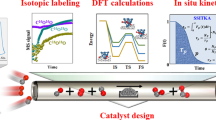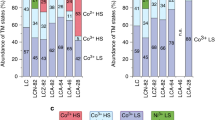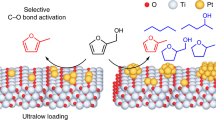Abstract
Catalysis by high-valent metals such as titanium(IV) impacts our lives daily through reactions like olefin polymerization. In any catalysis, optimization involves a careful choice of not just the metal but also the ancillary ligands. Because these choices dramatically impact the electronic structure of the system and, in turn, catalyst performance, new tools for catalyst development are needed. Understanding ancillary ligand effects is arguably one of the most critical aspects of catalyst optimization and, while parameters for phosphines have been used for decades with low-valent systems, a comparable system does not exist for high-valent metals. A new electronic parameter for ligand donation, derived from experiments on a high-valent chromium species, is now available. Here, we show that the new parameters enable quantitative determination of ancillary ligand effects on catalysis rate and, in some cases, even provide mechanistic information. Analysing reactions in this way can be used to design better catalyst architectures and paves the way for the use of such parameters in a host of high-valent processes.
This is a preview of subscription content, access via your institution
Access options
Access Nature and 54 other Nature Portfolio journals
Get Nature+, our best-value online-access subscription
$29.99 / 30 days
cancel any time
Subscribe to this journal
Receive 12 print issues and online access
$259.00 per year
only $21.58 per issue
Buy this article
- Purchase on Springer Link
- Instant access to full article PDF
Prices may be subject to local taxes which are calculated during checkout




Similar content being viewed by others

References
Pauling, L. Nature of the chemical bond. IV. The energy of single bonds and the relative electronegativity of atoms. J. Am. Chem. Soc. 54, 3570–3582 (1932).
Adams, C. Applied catalysis: a predictive socioeconomic history. Top. Catal. 52, 924–934 (2009).
Tolman, C. A. Steric effects of phosphorus ligands in organometallic chemistry and homogeneous catalysis. Chem. Rev. 77, 313–348 (1977).
Alt, H. G. & Köppl, A. Effect of the nature of metallocene complexes of group IV metals on their performance in catalytic ethylene and propylene polymerization. Chem. Rev. 100, 1205–1221 (2000).
Klosin, J., Fontaine, P. P. & Figueroa, R. Development of group IV molecular catalysts for high temperature ethylene-α-olefin copolymerization reactions. Acc. Chem. Res. 48, 2004–2016 (2015).
Sharpless, K. B. Searching for new reactivity (Nobel Lecture). Angew. Chem. Int. Ed. 41, 2024–2032 (2002).
Riera, A. & Moreno, M. Synthetic applications of chiral unsaturated epoxy alcohols prepared by sharpless asymmetric epoxidation. Molecules 15, 1041–1073 (2010).
Niemeyer, Z., Milo, A., Hickey, D. P. & Sigman, M. S. Parameterization of phosphine ligands reveals mechanistic pathways and predicts reaction outcomes. Nat. Chem. 8, 610–617 (2016).
Nelson, D. J. & Nolan, S. P. Quantifying and understanding the electronic properties of N-heterocyclic carbenes. Chem. Soc. Rev. 42, 6723–6753 (2013).
Mougel, V. et al. Quantitatively analyzing metathesis catalyst activity and structural features in silica-supported tungsten imido-alkylidene complexes. J. Am. Chem. Soc. 137, 6699–6704 (2015).
Bemowski, R. D., Singh, A. K., Bajorek, B. J., DePorre, Y. & Odom, A. L. Effective donor abilities of E-t-Bu and EPh (E = O, S, Se, Te) to a high valent transition metal. Dalton Trans. 43, 12299–12305 (2014).
DiFranco, S. A., Maciulis, N. A., Staples, R. J., Batrice, R. J. & Odom, A. L. Evaluation of donor and steric properties of anionic ligands on high valent transition metals. Inorg. Chem. 51, 1187–1200 (2012).
Muller, T. E., Hultzsch, K. C., Yus, M., Foubelo, F. & Tada, M. Hydroamination: direct addition of amines to alkenes and alkynes. Chem. Rev. 108, 3795–3892 (2008).
Odom, A. L. & McDaniel, T. J. Titanium-catalyzed multicomponent couplings: efficient one-pot synthesis of nitrogen heterocycles. Acc. Chem. Res. 48, 2822–2833 (2015).
Zachary, Z. W., Hue, R. J. & Tonks, I. A. Catalytic formal [2 + 2 + 1] synthesis of pyrroles from alkynes and diazenes via TiII/TiIV redox catalysis. Nat. Chem. 8, 63–68 (2016).
Duncan, A. P. & Bergman, R. G. Selective transformations of organic compounds by imidozirconocene complexes. Chem. Rec. 2, 431–445 (2002).
Pohlki, F. & Doye, S. The mechanism of the [Cp2TiMe2]-catalyzed intermolecular hydroamination of alkynes. Angew. Chem. Int. Ed. 40, 2305–2308 (2001).
Falivene, L. et al. SambVca 2. A web tool for analysing catalytic pockets with topographic steric maps. Organometallics 35, 2286–2293 (2016).
Clavier, H. & Nolan, S. P. Percent buried volume for phosphine and N-heterocylic carbene ligands: steric properties in organometallic chemistry. Chem. Commun. 46, 841–861 (2010).
Swartz, D. L. II & Odom, A. L. Effects of 5,5-substitution on dipyrrolymethane ligand isomerization. Dalton Trans. 4254–4258 (2008).
Shi, Y., Ciszewski, J. T. & Odom, A. L. Ti(NMe2)4 as a precatalyst for hydroamination of alkynes with primary amines. Organometallics 20, 3967–3969 (2001).
Bexrud, J. A., Beard, J. D., Leitch, D. C. & Schafer, L. L. Intramolecular hydroamination of unactivated olefins with Ti(NMe2)4 as a precatalyst. Org. Lett. 7, 1959–1962 (2005).
Beaumier, E. P., Billow, B. S., Singh, A. K., Biros, S. M. & Odom, A. L. A complex with nitrogen single double, and triple bonds to the same chromium atom: synthesis, structure, and reactivity. Chem. Sci. 7, 2532–2536 (2016).
Acknowledgements
The authors acknowledge financial support from the US National Science Foundation under grant no. CHE-1562140. The authors thank R. Staples for assistance with X-ray crystallography.
Author information
Authors and Affiliations
Contributions
B.S.B. prepared and characterized all the chromium complexes, obtained the LDP values, carried out most of the X-ray diffraction studies used to obtain the %Vbur parameters, and modelled the rate data. T.J.M. synthesized the mono- and bi-dentate ligands, prepared and characterized all the titanium complexes, collected the rate data, and conducted the DOSY-NMR studies. A.L.O. conceived of the experiments and wrote the manuscript. All authors assisted in editing the manuscript and approved its contents.
Corresponding author
Ethics declarations
Competing interests
The authors declare no competing financial interests.
Supplementary information
Supplementary information
Supplementary information (PDF 10278 kb)
Supplementary information
Crystallographic data for compounds in this study (CIF 10622 kb)
Rights and permissions
About this article
Cite this article
Billow, B., McDaniel, T. & Odom, A. Quantifying ligand effects in high-oxidation-state metal catalysis. Nature Chem 9, 837–842 (2017). https://doi.org/10.1038/nchem.2843
Received:
Accepted:
Published:
Issue Date:
DOI: https://doi.org/10.1038/nchem.2843


